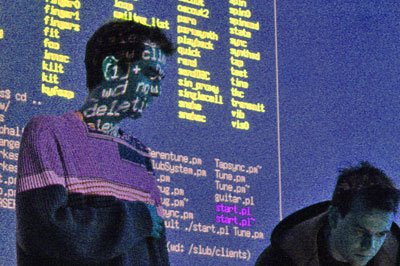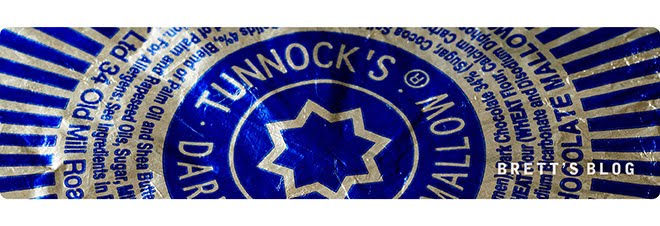
Wired reports:
A new brand of music maestro is turning programming into performance, eschewing turntables for a compiler and a mind for syntax structure. "Livecoding" practitioners improvise using Perl or homemade programming architectures to build compositions from the ground up, replacing instruments and samples with raw code authoring before a live audience.
Alex Maclean, a U.K. livecoder and art student, said he traded in his guitar when he found he could be more creative with code than with strings. He touch-types using Perl at raves and dance clubs, creating a unique visual and musical experience. Sessions with drummers, MCs and other livecoders can be reminiscent of traditional free-jazz improvisation.
"I tend to fall back on pre-prepared scripts if it's 3 o'clock in the morning and I've been drinking a lot," he said. "If I manage to stay sober, I will be much more daring and start from no code at all." Maclean, who plays up-tempo dance music with a trumpet-playing friend under the moniker Slub, performed and spoke on a panel at the Cybersonica festival in London in May.
He wrote his own custom text editor called Feedback.pl, which recompiles his programs continuously throughout a set. Every keystroke builds an evolving melody as his darting cursor adds and replaces functions and tempo variables. The live composition process is displayed to patrons on large projector screens.
Livecoders have formed an international consortium called TOPLAP, which stands for "temporary organization for the proliferation of live audio programming" and has 200 members. For them, livecoding is a philosophical challenge.

"By describing a musical idea in code, we're describing it at a higher level than if we're entering notes into a sequencer," Maclean said. "I've tried sequencers and found it a slow, difficult, maddening way of doing music. There's an atmosphere of musicians being subservient to software. It really limits the kind of music that can be made."
While some rely on popular languages like Perl, others write their own programming architectures. Open-source platforms like SuperCollider and ChucK, written at Princeton University's Sound Lab, have quickly gained Fender status with artists. Allied with animation and video libraries, the platforms give gig-goers a richer multimedia trip than code alone.
For example, livecoder Amy Alexander, an assistant professor in visual arts at the University of California at San Diego, wrote her own commands in Macromedia Director's Lingo scripting language to create a custom suite she calls Thingee. It produces an explosion of graphical color married with the output of performance commands like "bigify."
"Electronic music tends to remove the kinetic aspects of performance, the idea of seeing a performer perform a visible action that has an audible reaction," Alexander said. "Think Pete Townshend making windmill swipes at his guitar -- how do you do that in electronic performance?"
Alexander's shows involve frantic keyboard bashing and dancelike flourishes -- evidence that typing is becoming a performance medium.
At LiveCoda in Melbourne, Australia, in May, crowds gathered at a trendy local bar to watch teams of computer science graduates compete to debug image-compression algorithms on a wall-size screen, accompanied by a cappella beatboxers and DJs.
"Live programming where the code is projected for the audience is still very rare," said organizer Robert Shelton. "It exposes the means by which a performer shapes or controls sound."
For Maclean, who plays raves as well as programmer gatherings, the process is just as much about scripting as good vibe.
"I prefer it when the audience is dancing and doesn't care how we're making the music," he said. "Livecoding places the human right back in the creative process so you can't really call it 'computer-generated' any more. If we don't see programming music software as musical activity, we're missing an opportunity."
------------

No comments:
Post a Comment